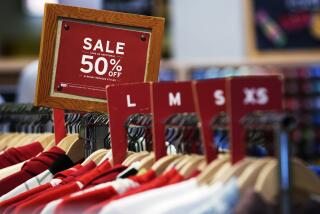Consumer Spending Drops 0.6% in January : Economy: The steepest slide in four years erases slight gains made in December and adds to evidence of a recession. Personal incomes fell 0.5%.
- Share via
WASHINGTON — Consumer spending, which slipped severely in the final quarter of 1990, dropped an additional 0.6% in January, the government said Thursday.
“Consumers are in a lot of trouble,” Bruce Steinberg, an economist with Merrill Lynch Capital Markets in New York, said of the sector providing two-thirds of the nation’s economic activity.
The Commerce Department said spending in January fell to a seasonally adjusted annual rate of $3.72 trillion, the steepest slide since a 1.3% drop in January, 1987, and more than erasing a 0.5% advance in December.
Economist John Silvia of Kemper Financial Services in Chicago said the decline is more evidence that the January-March period of 1991 will be the second quarterly contraction in a row--meeting the classic confirmation of recession.
The department reported on Wednesday that the gross national product--the total output of the nation’s goods and services--fell at an annual rate of 2% from October through December. That included a huge 2.9% drop in consumer spending.
And although the apparent end of the Persian Gulf War is expected to boost consumer confidence and provide an initial boost in spending, Steinberg said, any rebound is unlikely to be robust.
“The problem has not been a lack of confidence,” the Merrill Lynch economist said. “The problem is that consumers don’t have any money to spend.”
Indeed, the Commerce Department also reported Thursday that personal incomes fell 0.5%, the largest decline since a similar 0.5% decline in November, 1988.
Incomes totaled a seasonally adjusted annual rate of $4.72 trillion, down from a 0.6% gain posted in December.
The Labor Department reported earlier that America’s unemployment rate climbed to 6.2% in January, its highest level since 1987. During the seven months ending in January, 1.2 million people have become jobless.
And although there was an increase in some incomes because of a federal government pay raise and an increase in government benefit payments, it was offset by a decrease in farm subsidies and a jump in Social Security withholding, the Commerce Department said.
The report said Americans’ disposable incomes--incomes after taxes--sank 0.5%, erasing a 0.5% gain the previous month.
As a result, Americans’ savings rate--savings as a percentage of disposable income--edged up to 4.3% in January from 4.2% a month earlier.
The spending and income figures were not adjusted for inflation. When adjusted, spending actually fell 1.1%, the biggest decline since a 2.2% drop in January, 1987. Inflation-adjusted spending rose 0.4% in December.
Disposable incomes, when adjusted for inflation, slumped 0.9% after a 0.5% gain in December.
A key component of the income category--wages and salaries--fell $14.2 billion after rising $22.8 billion a month earlier. They were unchanged in November.
Spending on durable goods--big-ticket items ranging from cars to computers and expected to last more than three years--plunged $23.6 billion after a $2.4-billion drop in December.
The department said the decline “was mainly in purchases of motor vehicles,” continuing the pattern reported in the fourth-quarter GNP. The October-December decline “was centered in output of motor vehicles,” it said.
Spending on non-durable goods, which include food and clothing, was virtually flat, edging up just $200 million after a $1.1-billion decline the previous month.
And spending on services, which until recently had been immune from most recessionary pressures, slowed to a $2.4-billion gain from a $20.9-billion increase a month earlier.
More to Read
Inside the business of entertainment
The Wide Shot brings you news, analysis and insights on everything from streaming wars to production — and what it all means for the future.
You may occasionally receive promotional content from the Los Angeles Times.










